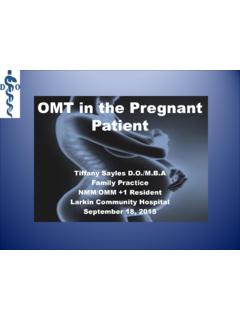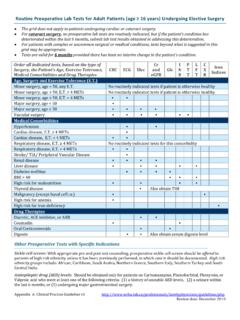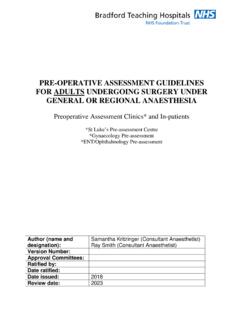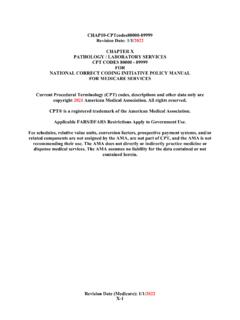Transcription of Preoperative Risk Assessment - FOMA
1 Preoperative Risk Assessment Joshua D. Lenchus, DO, RPh, FACP, SFHM Associate Professor of Clinical Medicine and Anesthesiology University of Miami Miller School of Medicine Miami, FL, USA Disclosures No financial or other material conflicts of interest The 2014 ACC-AHA Guidelines for Perioperative Cardiovascular Evaluation (Noncardiac Surgery) Case 57 year old woman is scheduled to undergo a laparoscopic cholecystectomy tomorrow. She has a h/o IDDM-2, also taking metformin, with good glucose control, and a resting heart rate of 60bpm. She walks 1 mile daily without any problem. Which of the following is the best recommendation for her pre-operatively? a)Proceed to surgery b)Begin beta-blockade, titrating to effect c)Order a cardiac stress test d)Consult cardiology for angiography Why Preoperative evaluation?
2 NOT CLEARANCE Assessment of perioperative risk Used to inform the decision to proceed or the choice of surgery Includes the patient s perspective Determination of the need for management changes Change medical therapies Perform further cardiovascular interventions Recommendations about postoperative monitoring Identification of cardiovascular conditions or risk factors requiring longer-term management Role of the Consultant Review available patient data, history and physical examination Determine if further testing is needed to define cardiovascular status Recommend treatment to improve medical condition Preoperative TESTING RECOMMENDED ONLY IF IT WILL CHANGE SURGICAL CARE OR PERIOPERATIVE MEDICAL THERAPY General Approach to the Patient-1 History unstable or severe angina, recent or past MI, decompensated HF, significant arrhythmias, severe vascular dz Comorbid Diseases pulmonary, diabetes mellitus, renal impairment, hematologic disorders Medications Rx, OTC, herbal, nutritional Social history alcohol, tobacco.
3 Illicit drugs General Approach to the Patient-2 Functional capacity measured in METs Physical Examination general appearance, VS, lung and cardiac auscultation Ancillary Studies - ECG may be indicated, blood chemistries and chest X-ray based on history and physical findings (Un)necessary ancillary testing 9/10 patients undergo at least 1 unnecessary test Why do it? Urban myth Medical liability Guideline distrust Ignorance Coagulation studies Mostly lab error; rarely predict bleeding risk Check thorough history Pregnancy testing Affects management in the proper population Also obtain menstrual bleeding history ECG History is better Stratify risk; establish baseline Not for asymptomatic patients and low-risk procedure CXR History is better Predictor, but doesn t change management Step 1: How urgent is the surgical procedure?
4 Steps 1 - 3: MACE = major adverse cardiac event MET = metabolic equivalent time GDMT = guideline directed medical therapy CPG = clinical practice guideline EMERGENCY Extremely limited time for clinical evaluation Life or limb is threatened if not in the OR within 6hrs URGENT Time for limited evaluation Life or limb is threatened if not in the OR 6-24hrs TIME-SENSITIVE Delay of > 1-6wks to allow for E&M will negatively affect outcome Most oncologic procedures ELECTIVE Procedure can be delayed up to 1yr Disease Specific Approaches artery disease (CAD) heart failure heart disease and conduction disorders implantable electronic devices vascular disease congenital heart disease Step 2.
5 Does the patient have ACS? Steps 1 - 3: MACE = major adverse cardiac event MET = metabolic equivalent time GDMT = guideline directed medical therapy CPG = clinical practice guideline Step 3: Perioperative risk Assessment Steps 1 - 3: MACE = major adverse cardiac event MET = metabolic equivalent time GDMT = guideline directed medical therapy CPG = clinical practice guideline Type of Surgery MACE: major adverse cardiac event of death or MI Low surgical risk (< 1%) Cataract surgery Plastic surgery Elevated surgical risk (> 1%) Peripheral vascular disease NOTE: prior risk classifications included intermediate. Since recommendations are similar, intermediate and elevated are grouped together. Revised Cardiac Risk Index (RCRI) Criteria ischemic heart disease angina or CP relieved with NTG remote MI (> 3 -6mos) EKG: pathological Q waves abnormal CST abnormal cardiac cath prior CABG or PCI compensated or prior HF cerebrovascular disease mellitus (insulin-dependent) insufficiency (SCr > 2mg/dL) surgical procedure 0- 1 RCRI = <1% mortality 2 RCRI = 2-7% mortality 3- 4 RCRI = 9-18% mortality >5 RCRI = >32% mortality Lee, TH.
6 Et al. Derivation and Prospective Validation of a Simple Index for Prediction of Cardiac Risk of Major Noncardiac Surgery, Circulation, 1999; 100: 1043. ACS NSQIP MICA Includes adjusted odds ratios for different surgical sites Target complications: arrest chaotic cardiac rhythm requiring initiation of basic or advanced life support infarction ( 1 of the following:) Documented EKG findings of MI ST elevation of 1mm in > 1 contiguous leads New LBBB New Q-wave in 2 contiguous leads Troponin > 3xnml in setting of suspected ischemia ACS NSQIP Surgical Risk Calculator Calculates risk of: , to OR intubation to rehab/nursing home, infection Cardiac Risk Stratification.
7 ACS NSQIP RCRI ACS NSQIP Calculator Creatinine > 2 ARF H/o heart failure H/o heart failure within 30 days IDDM DM Thoracic, Intra-abdominal, or vascular CPT code H/o ischemic heart disease Previous Cardiac event H/o CVA or TIA ASA status Age Wound class Ascites Sepsis Ventilator Disseminated cancer Steroid use HTN Previous MI Sex DOE Smoker COPD Dialysis BMI Emergence The American College of Cardiology Foundation (ACCF)/ American Heart Association (AHA) LOE and COR Table & Nomenclature Steps 4 and 5: Procedure-specific risk Assessment Steps 4 - 7: MACE = major adverse cardiac event MET = metabolic equivalent time GDMT = guideline directed medical therapy CPG = clinical practice guideline Step 5a : Functional capacity determination Steps 4 - 7: MACE = major adverse cardiac event MET = metabolic equivalent time GDMT = guideline directed medical therapy CPG = clinical practice guideline 2007 WRITING COMMITTEE MEMBERS, et al.
8 Circulation 2009;120:e169-e276 Estimated Energy Requirements for Various Activities Step 6: Poor/unknown functional capacity Steps 4 - 7: MACE = major adverse cardiac event MET = metabolic equivalent time GDMT = guideline directed medical therapy CPG = clinical practice guideline Stress Testing for Ischemia and Functional Status Recommendations: Test of choice is exercise ECG testing oProvides estimate of functional capacity oDetects myocardial ischemia through ECG changes and hemodynamic response Step 7: Surgery or alternative strategies Steps 4 - 7: MACE = major adverse cardiac event MET = metabolic equivalent time GDMT = guideline directed medical therapy CPG = clinical practice guideline Back to the case 57 year old woman is scheduled to undergo a laparoscopic cholecystectomy tomorrow.
9 She has a h/o IDDM-2, also taking metformin, with good glucose control, and a resting heart rate of 60bpm. She walks 1 mile daily without any problem. Which of the following tests would be appropriate? a)Resting ECG b)2D transthoracic echocardiogram c)Cardiac stress test d)Coronary angiography e)None of the above Supplemental Preoperative Evaluation Includes ECG Assessment of LV function Exercise Stress Testing for Myocardial Ischemia and Functional Capacity Pharmacological Stress Testing Noninvasive Radionuclide DSE Special Situations Supplemental Preoperative Evaluation Preop resting 12-lead EKG Known CHD, significant arrhythmia, PAD, cerebrovascular dz, structural HD, but not those undergoing low-risk surgery (IIa-B) Considered for asymptomatic patients without CHD, but not low-risk (IIb-B) Routine use in asymptomatic patients undergoing low-risk procedures (III-B)
10 Preop LV function Assessment Dyspnea of unknown origin (IIa-C) CHF with worsening dyspnea or other change in clinical status (IIa-C) Clinically stable, previously noted LV dysfunction, >1yr since last echo (IIb-C) Routine evaluation (III-B) Preoperative stress testing recommendations Exercise or Pharmacological Stress Test? Choice of stress: Patient s ability to exercise Baseline EKG ( BBB or paced) Choice of drug: Adenosine and Dipyridamole cause bronchospasm, transient AV block, hypotension, and are inhibited by xanthine use Dobutamine causes elevated BP and/or HR, increasing ischemia, and is inhibited by beta-blocker Regadenoson is contraindicated in high grade AV block or sinus node dysfunction Pharmacological Stress Testing Noninvasive Reasonable (Class IIa) for patients at elevated risk and have poor FC (either DSE or pharm stress MPI) (LOE=B) No Benefit (Class III) for routine screening for patients undergoing low-risk noncardiac surgery (LOE=B)








